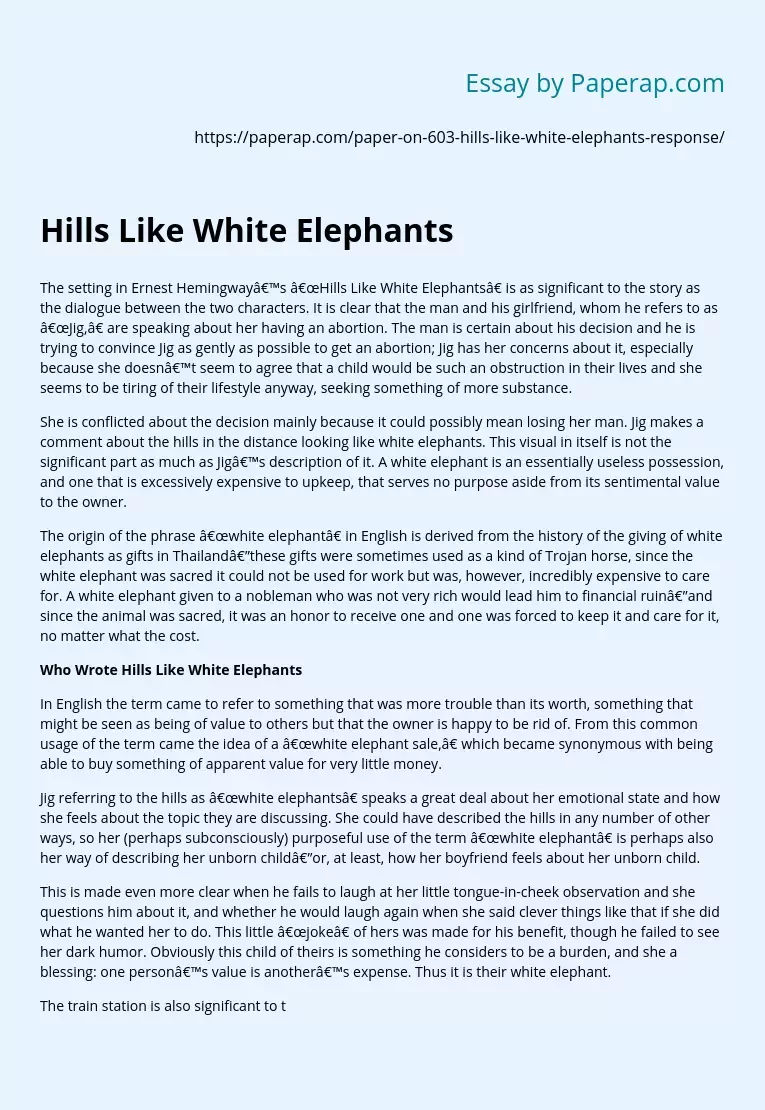Hills Like White Elephants
The setting in Ernest Hemingway’s “Hills Like White Elephants” is as significant to the story as the dialogue between the two characters. It is clear that the man and his girlfriend, whom he refers to as “Jig,” are speaking about her having an abortion. The man is certain about his decision and he is trying to convince Jig as gently as possible to get an abortion; Jig has her concerns about it, especially because she doesn’t seem to agree that a child would be such an obstruction in their lives and she seems to be tiring of their lifestyle anyway, seeking something of more substance.
She is conflicted about the decision mainly because it could possibly mean losing her man. Jig makes a comment about the hills in the distance looking like white elephants. This visual in itself is not the significant part as much as Jig’s description of it. A white elephant is an essentially useless possession, and one that is excessively expensive to upkeep, that serves no purpose aside from its sentimental value to the owner.
The origin of the phrase “white elephant” in English is derived from the history of the giving of white elephants as gifts in Thailand—these gifts were sometimes used as a kind of Trojan horse, since the white elephant was sacred it could not be used for work but was, however, incredibly expensive to care for. A white elephant given to a nobleman who was not very rich would lead him to financial ruin—and since the animal was sacred, it was an honor to receive one and one was forced to keep it and care for it, no matter what the cost.
Who Wrote Hills Like White Elephants
In English the term came to refer to something that was more trouble than its worth, something that might be seen as being of value to others but that the owner is happy to be rid of. From this common usage of the term came the idea of a “white elephant sale,” which became synonymous with being able to buy something of apparent value for very little money.
Jig referring to the hills as “white elephants” speaks a great deal about her emotional state and how she feels about the topic they are discussing. She could have described the hills in any number of other ways, so her (perhaps subconsciously) purposeful use of the term “white elephant” is perhaps also her way of describing her unborn child—or, at least, how her boyfriend feels about her unborn child.
This is made even more clear when he fails to laugh at her little tongue-in-cheek observation and she questions him about it, and whether he would laugh again when she said clever things like that if she did what he wanted her to do. This little “joke” of hers was made for his benefit, though he failed to see her dark humor. Obviously this child of theirs is something he considers to be a burden, and she a blessing: one person’s value is another’s expense. Thus it is their white elephant.
The train station is also significant to their story because it is the literal representation of them being figuratively at a crossroads. The express train can continue to whisk them away from one location to the next to the next, as they have been doing for some time (as seen by the number of stickers on their luggage), or they can (figuratively) stay off of the train, or take another path, and enjoy the beauty of what is around them, ceasing the endless running from one place to another.
The opposing train tracks are the choices they have to make: one leads them down the same path they’ve been screaming down all along, and the other leads them down an entirely different path, with an entirely different pace and different priorities, but which has a beauty all its own—a beauty that Jig sees but her man does not.
Hills Like White Elephants. (2019, Dec 05). Retrieved from https://paperap.com/paper-on-603-hills-like-white-elephants-response/

